.
FRANCE 2012
Day 16, Tuesday, September 18
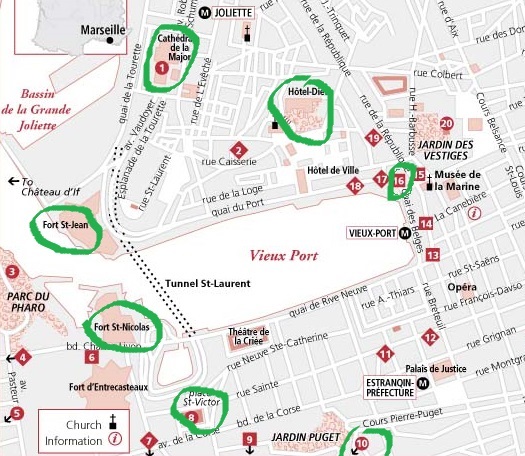
Marseilles
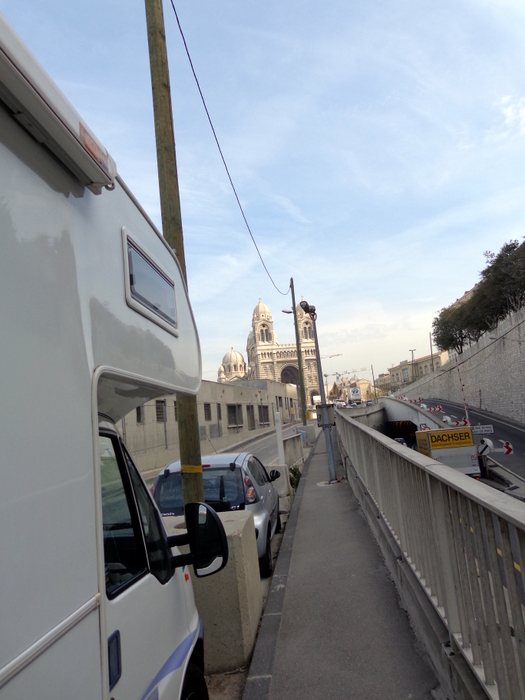 We
started our day, after breakfast in the hotel, with a walk through the
old area to the cathedral. It was a rather long walk, and you guessed
it, uphill. We were on a road with a narrow side walk that was at the
end of the big harbor with the huge ships.
We
started our day, after breakfast in the hotel, with a walk through the
old area to the cathedral. It was a rather long walk, and you guessed
it, uphill. We were on a road with a narrow side walk that was at the
end of the big harbor with the huge ships.
No 16 is our
hotel. No 1 (near left top) is the cathedral
There are two cathedrals side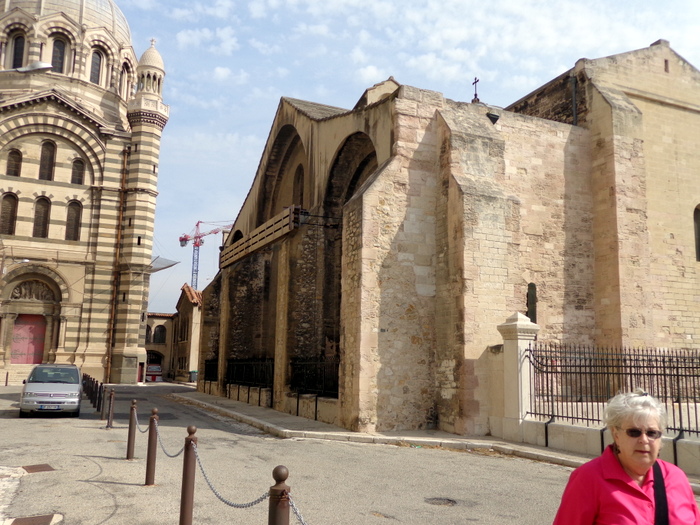 by side. Several buildings have stood on these foundations since the
5th century but the current Roman Provencal style church ( the old
cathedral) built in pink
stone from the Couronne quarries dates back to the mid-12th century.
by side. Several buildings have stood on these foundations since the
5th century but the current Roman Provencal style church ( the old
cathedral) built in pink
stone from the Couronne quarries dates back to the mid-12th century.
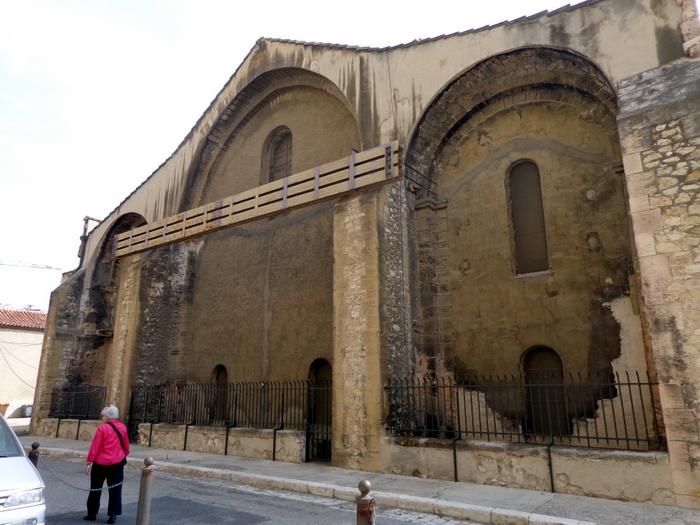 The
Old Cathedral is named Vieille Major . The bell tower wasn’t built until
the 14th century. It was a cathedral until 1852 when the new cathedral
began, but was still used as a parish church until the 1950s. The
building of the new cathedral removed two of the Vieille Major’s bays.
The Vieille Major isn’t open to visitors.There was a fence around the
old cathedral so it wasn’t possible to go in.
The
Old Cathedral is named Vieille Major . The bell tower wasn’t built until
the 14th century. It was a cathedral until 1852 when the new cathedral
began, but was still used as a parish church until the 1950s. The
building of the new cathedral removed two of the Vieille Major’s bays.
The Vieille Major isn’t open to visitors.There was a fence around the
old cathedral so it wasn’t possible to go in.
The new cathedral was build from 1852-1893. The Romanesq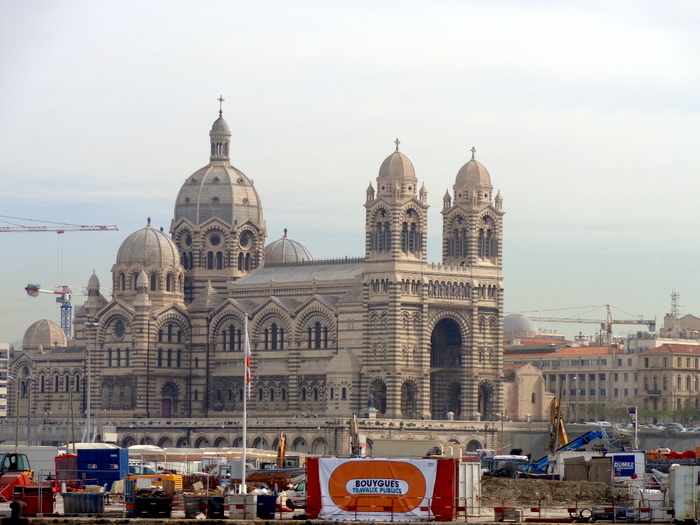 ue
– and Byzantine style Cathedral is extremely large with striped exterior
stone,built from a variety of materials from many different places
including Greenstone from Florence and mosaics from Venice.
ue
– and Byzantine style Cathedral is extremely large with striped exterior
stone,built from a variety of materials from many different places
including Greenstone from Florence and mosaics from Venice.
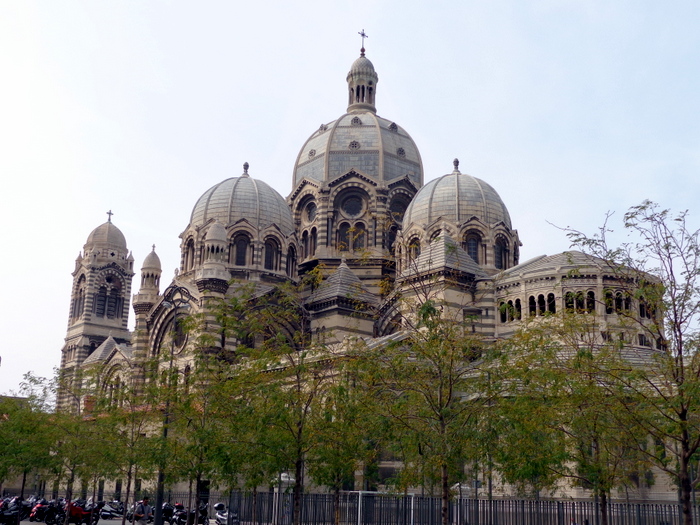 The
Major cathedral is 470 feet long and the front towers reach 200 feet. The central dome is perhaps the most impressive and the
most beautiful aspect of the Marseille Cathedral, which is 235 feet
tall. There are a total of five domes.
The
Major cathedral is 470 feet long and the front towers reach 200 feet. The central dome is perhaps the most impressive and the
most beautiful aspect of the Marseille Cathedral, which is 235 feet
tall. There are a total of five domes.
The inside is decorated in beautiful mosaics. In the fro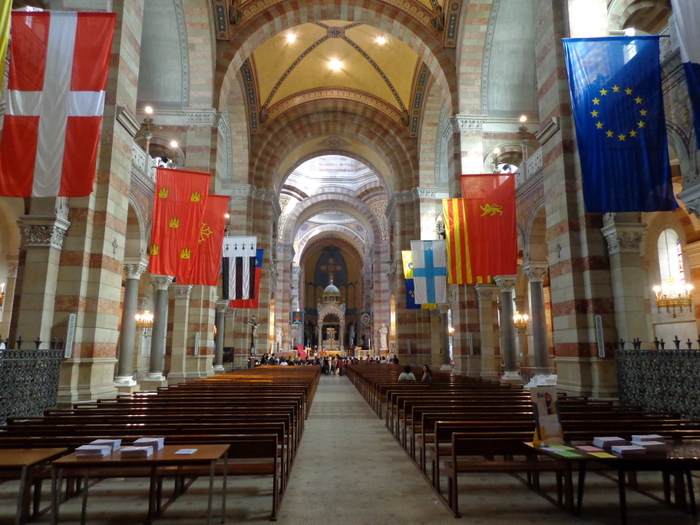 nt
sections of the church were a large number of school children and their
teachers. A teacher was telling them something – we couldn’t
understand, then accompanied by a guitar the children would sing a
delightful little song.
nt
sections of the church were a large number of school children and their
teachers. A teacher was telling them something – we couldn’t
understand, then accompanied by a guitar the children would sing a
delightful little song.
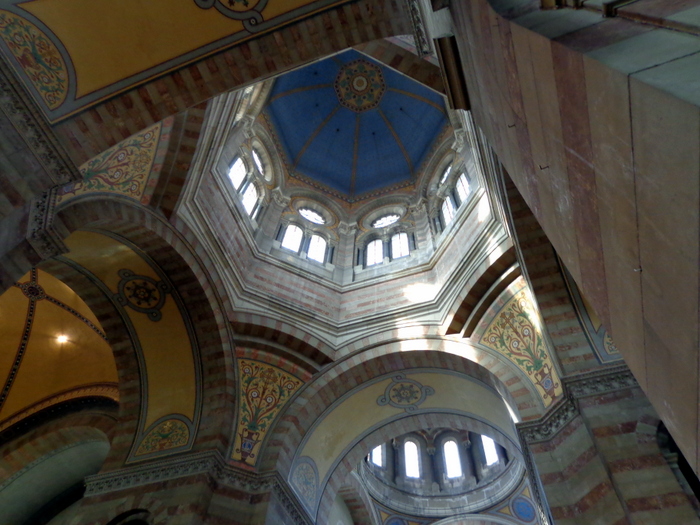 We
did spend a long time looking at the wonders of this cathedral.
We
did spend a long time looking at the wonders of this cathedral.
Our next visit was to the La Vieille Charité is a former almshouse,
now functioning as a museum and cultural centre, situated in the heart
of the old P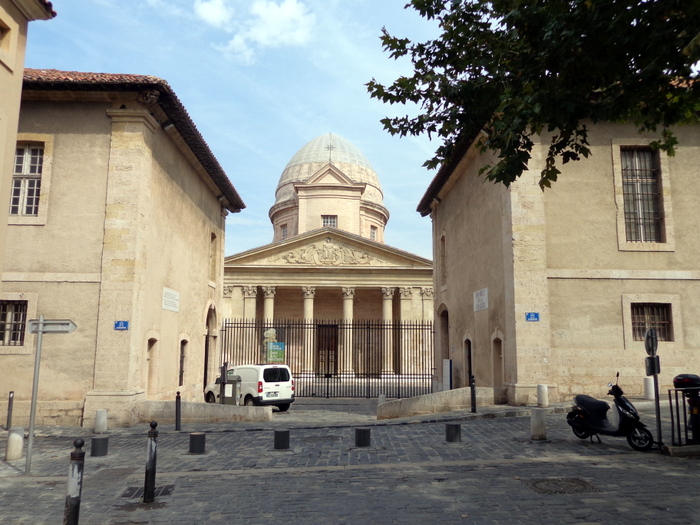 anier
quarter, not far from the Cathedral. The La vieille Charité was
constructed between 1671 and 1749 in the Baroque style to the designs of
the architect Pierre Puget. It comprises four three-story arcaded
galleries surrounding a round church, crowned by an ellipsoidal dome and
fronted by a portico in the classical style with Corinthian columns.
This Baroque chapel ranks as one of Puget's most original designs. It
was very quiet and inspiring place.
anier
quarter, not far from the Cathedral. The La vieille Charité was
constructed between 1671 and 1749 in the Baroque style to the designs of
the architect Pierre Puget. It comprises four three-story arcaded
galleries surrounding a round church, crowned by an ellipsoidal dome and
fronted by a portico in the classical style with Corinthian columns.
This Baroque chapel ranks as one of Puget's most original designs. It
was very quiet and inspiring place.
I n
the seventeenth century the repression of beggars was conducted with
great brutality in France. The almshouses served as workhouses for the
beggars. Children were found jobs as domestic servants, cabin
boys or apprentices with seamstresses or bakers. As time passed the work
of la Vielle Charité grew, the number of inmates increasing from 850 in
1736 to 1059 in 1760. As the imprisonment of the poor became less
acceptable, the numbers decreased to 250 in 1781.
n
the seventeenth century the repression of beggars was conducted with
great brutality in France. The almshouses served as workhouses for the
beggars. Children were found jobs as domestic servants, cabin
boys or apprentices with seamstresses or bakers. As time passed the work
of la Vielle Charité grew, the number of inmates increasing from 850 in
1736 to 1059 in 1760. As the imprisonment of the poor became less
acceptable, the numbers decreased to 250 in 1781.
Spared during the French Revolution, the building was used as an
asylum for vagrants and the dispossessed in the nineteenth century. It was
transformed into a barracks for the French Foreign Legion until 1922,
later for those made homeless by the dynamiting of the Old Port during
World War II. In 1962 all the residents were rehoused and the building
shut down. It was only in 1968 that funds became available to rescue the
buildings, by then in a state of total dereliction. La Vieille Charité
was painstakingly restored to its former glory between 1970 and 1986,
restoration of the chapel being completed in 1981.
We walked back down some of the street that we
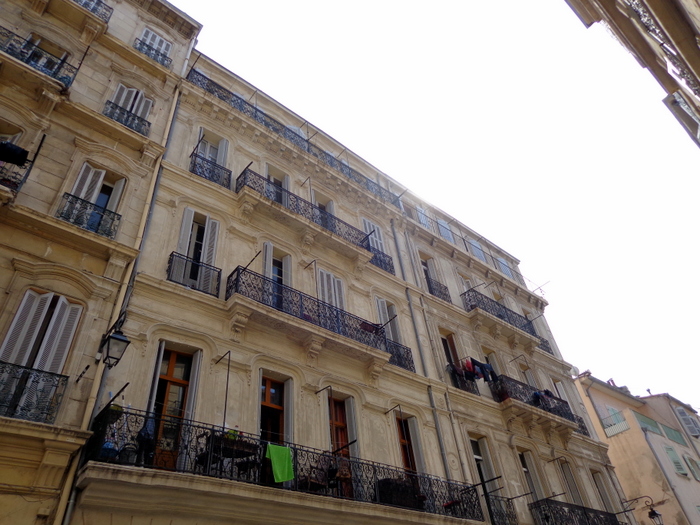 had
just come up and passed through an area called the Panier-old Marseille.
Seeing the old apartment buildings with iron balconies and clothes
handing on them was a fun experience. We got back down to the area
around the old port and stopped in one of the many, many outdoor cafes
and had a pizza for lunch. We then walked to our hotel,
dropped off the book that I had bought, and headed for the boat dock.
had
just come up and passed through an area called the Panier-old Marseille.
Seeing the old apartment buildings with iron balconies and clothes
handing on them was a fun experience. We got back down to the area
around the old port and stopped in one of the many, many outdoor cafes
and had a pizza for lunch. We then walked to our hotel,
dropped off the book that I had bought, and headed for the boat dock.
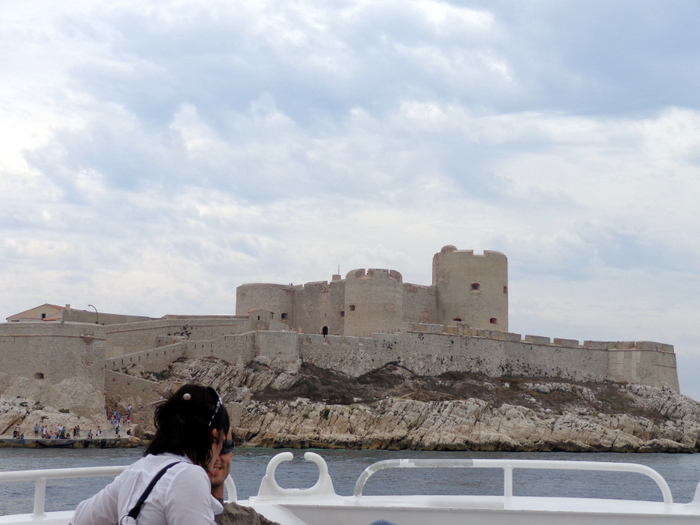 We
bought our ticket for a cruise to Chateau D’If – it was closed
yesterday. It was about a half hour ride.
We
bought our ticket for a cruise to Chateau D’If – it was closed
yesterday. It was about a half hour ride.
We landed and saw this huge
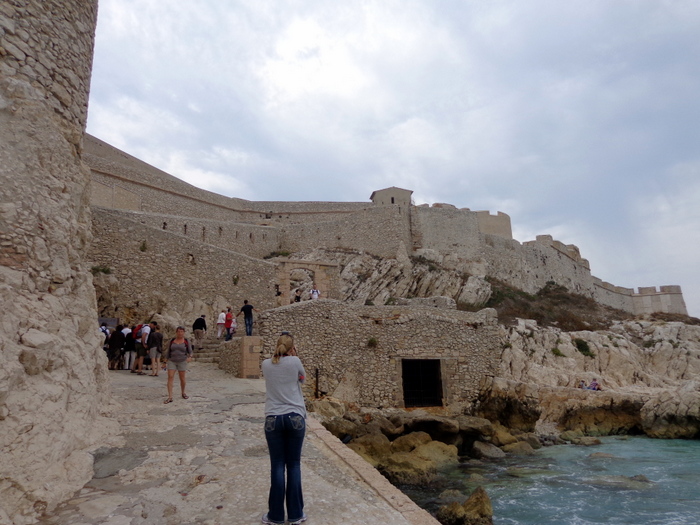 castle
high on the hill – guess what? A lot of steps and steep paths. Chateau
D’If was built in 1524 by Francois I as an island fortress for
prisoners. It is presently best known as the prison that held the Count
of Monte Cristo in Alexander Dumas’ novel. We could stay as long as we
liked and catch another boat back.
castle
high on the hill – guess what? A lot of steps and steep paths. Chateau
D’If was built in 1524 by Francois I as an island fortress for
prisoners. It is presently best known as the prison that held the Count
of Monte Cristo in Alexander Dumas’ novel. We could stay as long as we
liked and catch another boat back.
We managed to finally climb up the top of the fort. There were
several buildings there plus the actual
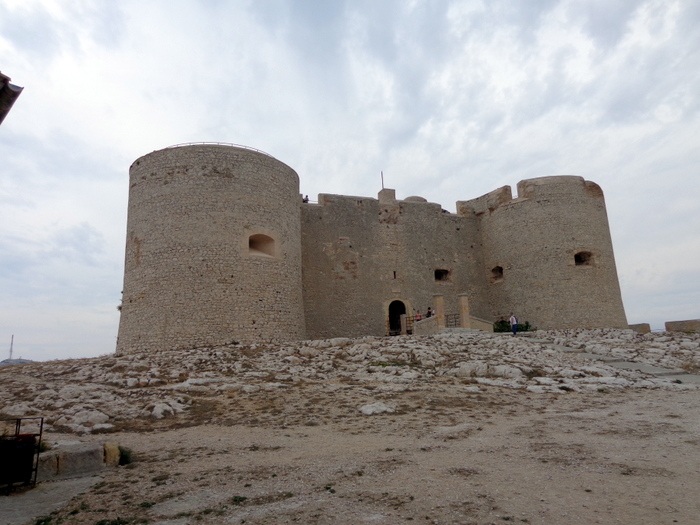 fort
or prison. We went inside – more steps!
fort
or prison. We went inside – more steps!
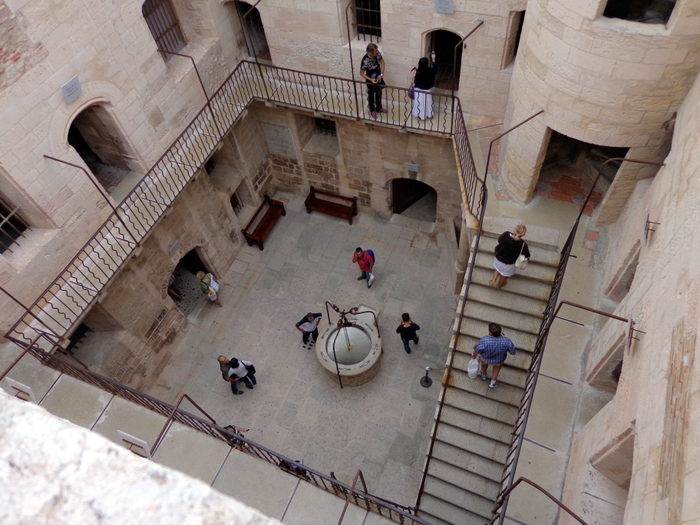
There was a central courtyard – three stories high with cells on all
four sides.
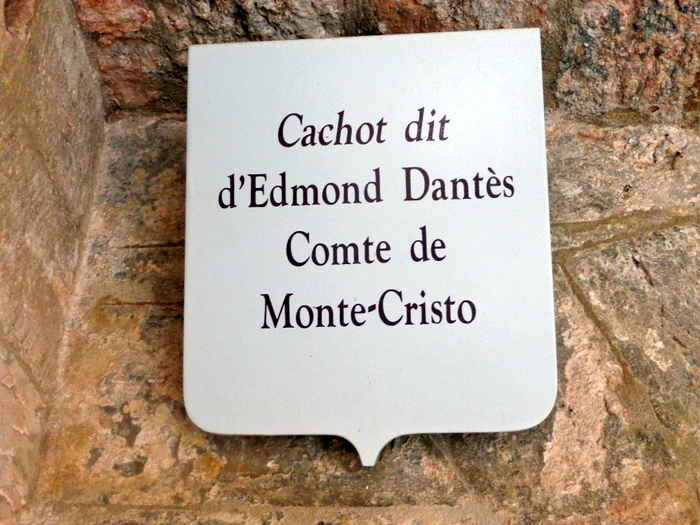
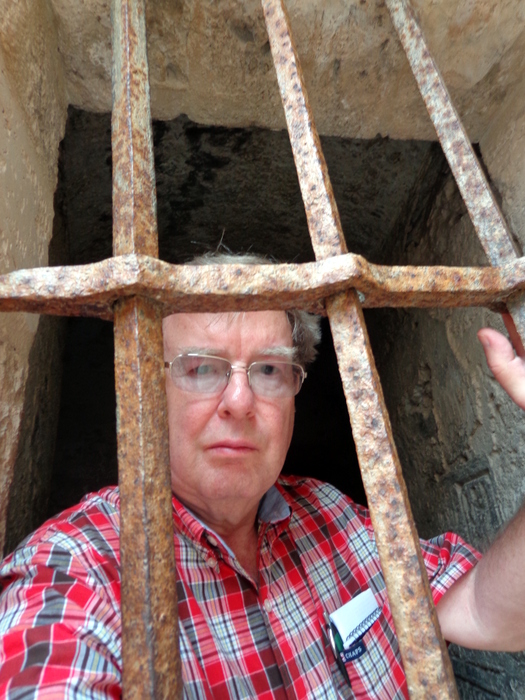
One was marked for the Count of Monte Cristo. Kathleen didn’t
think she could make it up the rest of the steps, but I went up and
explored the cells. I got locked up for a while!
There were a set of steep circular steps in a tower leading the very
top, so I said “why not”. The view all around was breath taking. Today
had been hot, and a little overcast but still you could see for miles.
We got back about 6:00.
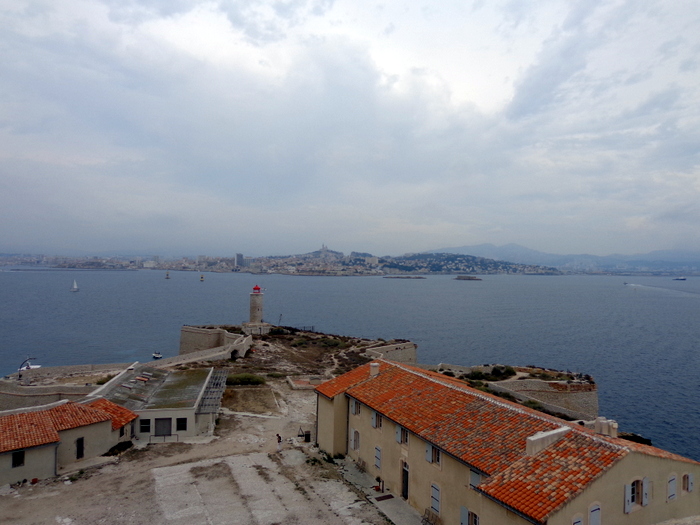
Near our hotel was a church, Église
Saint-Ferréol les Augustins, that we had seen many times but had not visited. It took a while to get
to it because of all of the construction. The original building on site
was owned by the Knights Templar's. 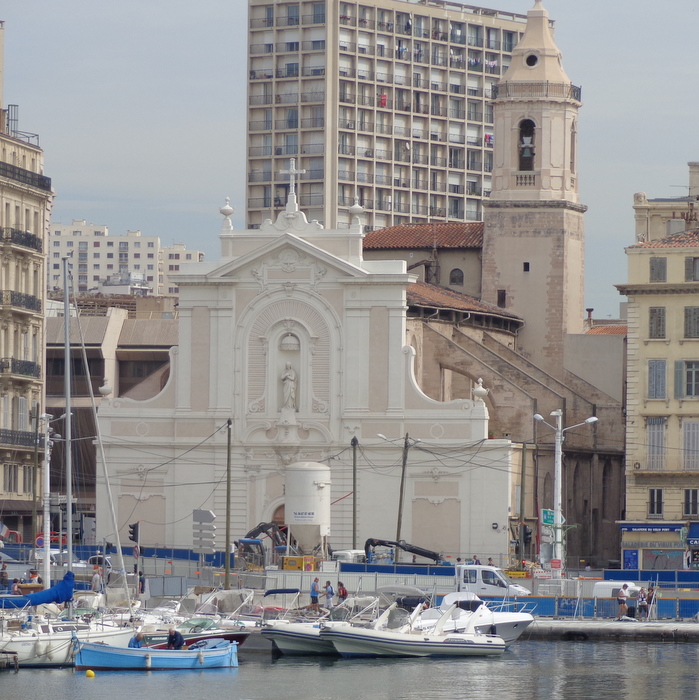 In 1369, it was given to a community of Augustinian hermits. By 1447,
they decided to construct a new church building. It was dedicated in
1542, even though the vault was only completed in 1588. During
the French Revolution, it came close to being destroyed, but was
salvaged. Later it was renamed in honor of St. Augustine. The façade was
destroyed in 1801 due to construction work on the street, and it was
rebuilt in 1875. In 1803, it was named in honor of Saint Ferreol de
Vienne, a Roman Catholic martyr from the 3rd century who was the
namesake of
In 1369, it was given to a community of Augustinian hermits. By 1447,
they decided to construct a new church building. It was dedicated in
1542, even though the vault was only completed in 1588. During
the French Revolution, it came close to being destroyed, but was
salvaged. Later it was renamed in honor of St. Augustine. The façade was
destroyed in 1801 due to construction work on the street, and it was
rebuilt in 1875. In 1803, it was named in honor of Saint Ferreol de
Vienne, a Roman Catholic martyr from the 3rd century who was the
namesake of
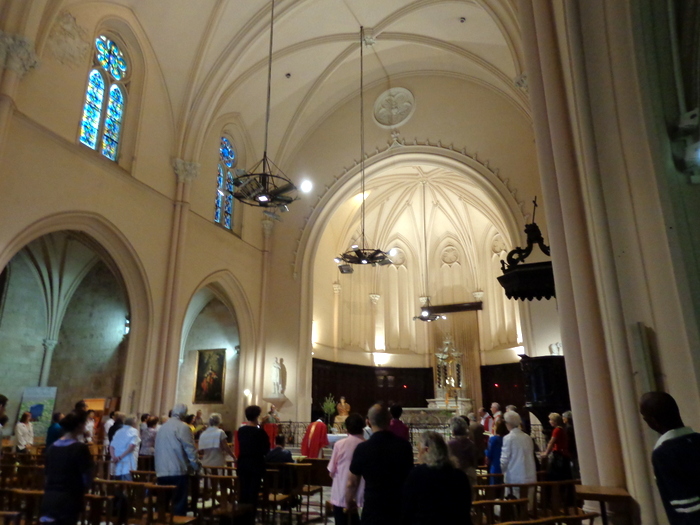 another
church in Marseille which was destroyed during the French Revolution.
We found our way inside and mass was just ending. We didn't stay
long.
another
church in Marseille which was destroyed during the French Revolution.
We found our way inside and mass was just ending. We didn't stay
long.
Speaking of construction the nearly revitalized section of road in
front of the hotel was opened this morning. It is all paving stones.
The project is very large, and as I said yesterday quite noisy.
We stopped in a little café several door from our hotel for a
drink. Back to the hotel for a few minutes and then walked back around
the old port for dinner. Kathleen had reserved months ago this
restaurant that she read about on
 Trip
Advisor. It was called La Table du Fort. It was entirely inside and
had 20 tables. The menu was all in French with no English translation.
Kathleen ordered for a starter what she thought for a fish soup, but
turned out to be a nice fish pate. I didn’t order a starter. For our
main course we ordered lamb – we could read that. It was the best piece
of lamb that I have ever had. It came with couscous and a few lima
beans. We had some kind of tart, which also was delicious, for
dessert. It was sort of a culinary mystery evening, and we risked by not
understanding the full menu, but oh wow the food was good.
Trip
Advisor. It was called La Table du Fort. It was entirely inside and
had 20 tables. The menu was all in French with no English translation.
Kathleen ordered for a starter what she thought for a fish soup, but
turned out to be a nice fish pate. I didn’t order a starter. For our
main course we ordered lamb – we could read that. It was the best piece
of lamb that I have ever had. It came with couscous and a few lima
beans. We had some kind of tart, which also was delicious, for
dessert. It was sort of a culinary mystery evening, and we risked by not
understanding the full menu, but oh wow the food was good.
Well we leave here tomorrow, leading for a little town called Aigues
Mortes.

 We
started our day, after breakfast in the hotel, with a walk through the
old area to the cathedral. It was a rather long walk, and you guessed
it, uphill. We were on a road with a narrow side walk that was at the
end of the big harbor with the huge ships.
We
started our day, after breakfast in the hotel, with a walk through the
old area to the cathedral. It was a rather long walk, and you guessed
it, uphill. We were on a road with a narrow side walk that was at the
end of the big harbor with the huge ships.  by side. Several buildings have stood on these foundations since the
5th century but the current Roman Provencal style church ( the old
cathedral) built in pink
stone from the Couronne quarries dates back to the mid-12th century.
by side. Several buildings have stood on these foundations since the
5th century but the current Roman Provencal style church ( the old
cathedral) built in pink
stone from the Couronne quarries dates back to the mid-12th century.
 The
Old Cathedral is named Vieille Major . The bell tower wasn’t built until
the 14th century. It was a cathedral until 1852 when the new cathedral
began, but was still used as a parish church until the 1950s. The
building of the new cathedral removed two of the Vieille Major’s bays.
The Vieille Major isn’t open to visitors.There was a fence around the
old cathedral so it wasn’t possible to go in.
The
Old Cathedral is named Vieille Major . The bell tower wasn’t built until
the 14th century. It was a cathedral until 1852 when the new cathedral
began, but was still used as a parish church until the 1950s. The
building of the new cathedral removed two of the Vieille Major’s bays.
The Vieille Major isn’t open to visitors.There was a fence around the
old cathedral so it wasn’t possible to go in.  ue
– and Byzantine style Cathedral is extremely large with striped exterior
stone,built from a variety of materials from many different places
including Greenstone from Florence and mosaics from Venice.
ue
– and Byzantine style Cathedral is extremely large with striped exterior
stone,built from a variety of materials from many different places
including Greenstone from Florence and mosaics from Venice. The
Major cathedral is 470 feet long and the front towers reach 200 feet. The central dome is perhaps the most impressive and the
most beautiful aspect of the Marseille Cathedral, which is 235 feet
tall. There are a total of five domes.
The
Major cathedral is 470 feet long and the front towers reach 200 feet. The central dome is perhaps the most impressive and the
most beautiful aspect of the Marseille Cathedral, which is 235 feet
tall. There are a total of five domes.  nt
sections of the church were a large number of school children and their
teachers. A teacher was telling them something – we couldn’t
understand, then accompanied by a guitar the children would sing a
delightful little song.
nt
sections of the church were a large number of school children and their
teachers. A teacher was telling them something – we couldn’t
understand, then accompanied by a guitar the children would sing a
delightful little song.  We
did spend a long time looking at the wonders of this cathedral.
We
did spend a long time looking at the wonders of this cathedral.  anier
quarter, not far from the Cathedral. The La vieille Charité was
constructed between 1671 and 1749 in the Baroque style to the designs of
the architect Pierre Puget. It comprises four three-story arcaded
galleries surrounding a round church, crowned by an ellipsoidal dome and
fronted by a portico in the classical style with Corinthian columns.
This Baroque chapel ranks as one of Puget's most original designs. It
was very quiet and inspiring place.
anier
quarter, not far from the Cathedral. The La vieille Charité was
constructed between 1671 and 1749 in the Baroque style to the designs of
the architect Pierre Puget. It comprises four three-story arcaded
galleries surrounding a round church, crowned by an ellipsoidal dome and
fronted by a portico in the classical style with Corinthian columns.
This Baroque chapel ranks as one of Puget's most original designs. It
was very quiet and inspiring place.  n
the seventeenth century the repression of beggars was conducted with
great brutality in France. The almshouses served as workhouses for the
beggars. Children were found jobs as domestic servants, cabin
boys or apprentices with seamstresses or bakers. As time passed the work
of la Vielle Charité grew, the number of inmates increasing from 850 in
1736 to 1059 in 1760. As the imprisonment of the poor became less
acceptable, the numbers decreased to 250 in 1781.
n
the seventeenth century the repression of beggars was conducted with
great brutality in France. The almshouses served as workhouses for the
beggars. Children were found jobs as domestic servants, cabin
boys or apprentices with seamstresses or bakers. As time passed the work
of la Vielle Charité grew, the number of inmates increasing from 850 in
1736 to 1059 in 1760. As the imprisonment of the poor became less
acceptable, the numbers decreased to 250 in 1781.  had
just come up and passed through an area called the Panier-old Marseille.
Seeing the old apartment buildings with iron balconies and clothes
handing on them was a fun experience. We got back down to the area
around the old port and stopped in one of the many, many outdoor cafes
and had a pizza for lunch. We then walked to our hotel,
dropped off the book that I had bought, and headed for the boat dock.
had
just come up and passed through an area called the Panier-old Marseille.
Seeing the old apartment buildings with iron balconies and clothes
handing on them was a fun experience. We got back down to the area
around the old port and stopped in one of the many, many outdoor cafes
and had a pizza for lunch. We then walked to our hotel,
dropped off the book that I had bought, and headed for the boat dock.  We
bought our ticket for a cruise to Chateau D’If – it was closed
yesterday. It was about a half hour ride.
We
bought our ticket for a cruise to Chateau D’If – it was closed
yesterday. It was about a half hour ride.  castle
high on the hill – guess what? A lot of steps and steep paths. Chateau
D’If was built in 1524 by Francois I as an island fortress for
prisoners. It is presently best known as the prison that held the Count
of Monte Cristo in Alexander Dumas’ novel. We could stay as long as we
liked and catch another boat back.
castle
high on the hill – guess what? A lot of steps and steep paths. Chateau
D’If was built in 1524 by Francois I as an island fortress for
prisoners. It is presently best known as the prison that held the Count
of Monte Cristo in Alexander Dumas’ novel. We could stay as long as we
liked and catch another boat back.  fort
or prison. We went inside – more steps!
fort
or prison. We went inside – more steps! 
 In 1369, it was given to a community of Augustinian hermits. By 1447,
they decided to construct a new church building. It was dedicated in
1542, even though the vault was only completed in 1588. During
the French Revolution, it came close to being destroyed, but was
salvaged. Later it was renamed in honor of St. Augustine. The façade was
destroyed in 1801 due to construction work on the street, and it was
rebuilt in 1875. In 1803, it was named in honor of Saint Ferreol de
Vienne, a Roman Catholic martyr from the 3rd century who was the
namesake of
In 1369, it was given to a community of Augustinian hermits. By 1447,
they decided to construct a new church building. It was dedicated in
1542, even though the vault was only completed in 1588. During
the French Revolution, it came close to being destroyed, but was
salvaged. Later it was renamed in honor of St. Augustine. The façade was
destroyed in 1801 due to construction work on the street, and it was
rebuilt in 1875. In 1803, it was named in honor of Saint Ferreol de
Vienne, a Roman Catholic martyr from the 3rd century who was the
namesake of
 another
church in Marseille which was destroyed during the French Revolution.
We found our way inside and mass was just ending. We didn't stay
long.
another
church in Marseille which was destroyed during the French Revolution.
We found our way inside and mass was just ending. We didn't stay
long. Trip
Advisor. It was called La Table du Fort. It was entirely inside and
had 20 tables. The menu was all in French with no English translation.
Kathleen ordered for a starter what she thought for a fish soup, but
turned out to be a nice fish pate. I didn’t order a starter. For our
main course we ordered lamb – we could read that. It was the best piece
of lamb that I have ever had. It came with couscous and a few lima
beans. We had some kind of tart, which also was delicious, for
dessert. It was sort of a culinary mystery evening, and we risked by not
understanding the full menu, but oh wow the food was good.
Trip
Advisor. It was called La Table du Fort. It was entirely inside and
had 20 tables. The menu was all in French with no English translation.
Kathleen ordered for a starter what she thought for a fish soup, but
turned out to be a nice fish pate. I didn’t order a starter. For our
main course we ordered lamb – we could read that. It was the best piece
of lamb that I have ever had. It came with couscous and a few lima
beans. We had some kind of tart, which also was delicious, for
dessert. It was sort of a culinary mystery evening, and we risked by not
understanding the full menu, but oh wow the food was good. 